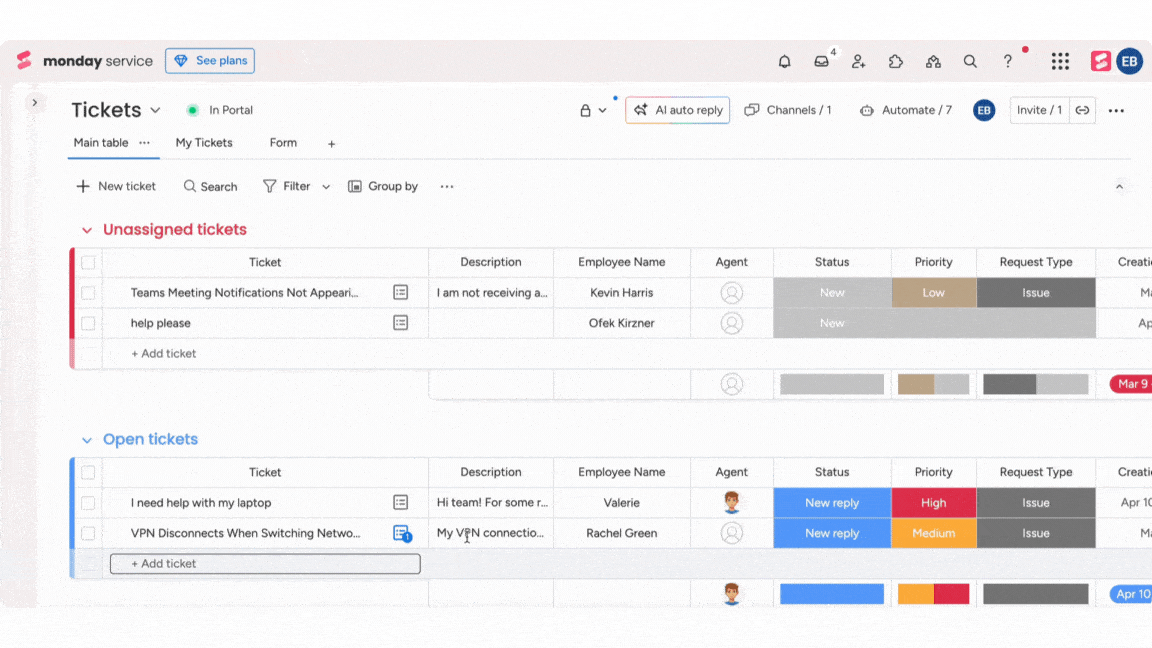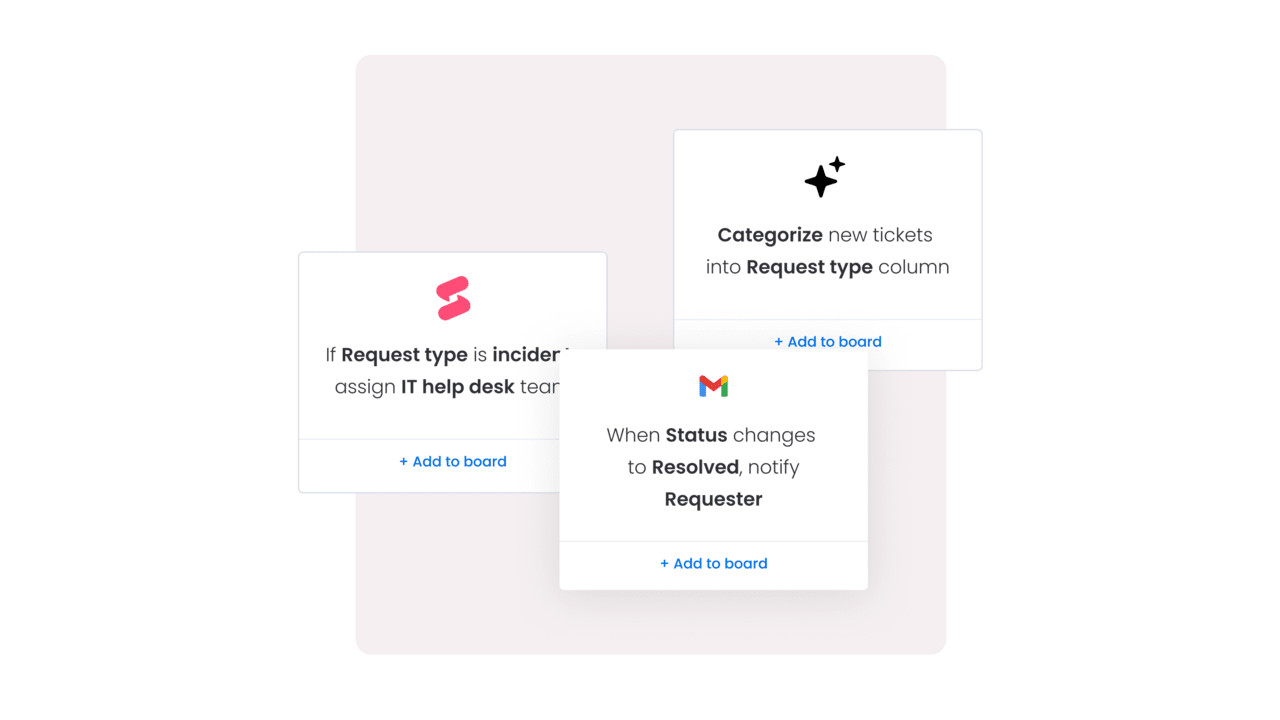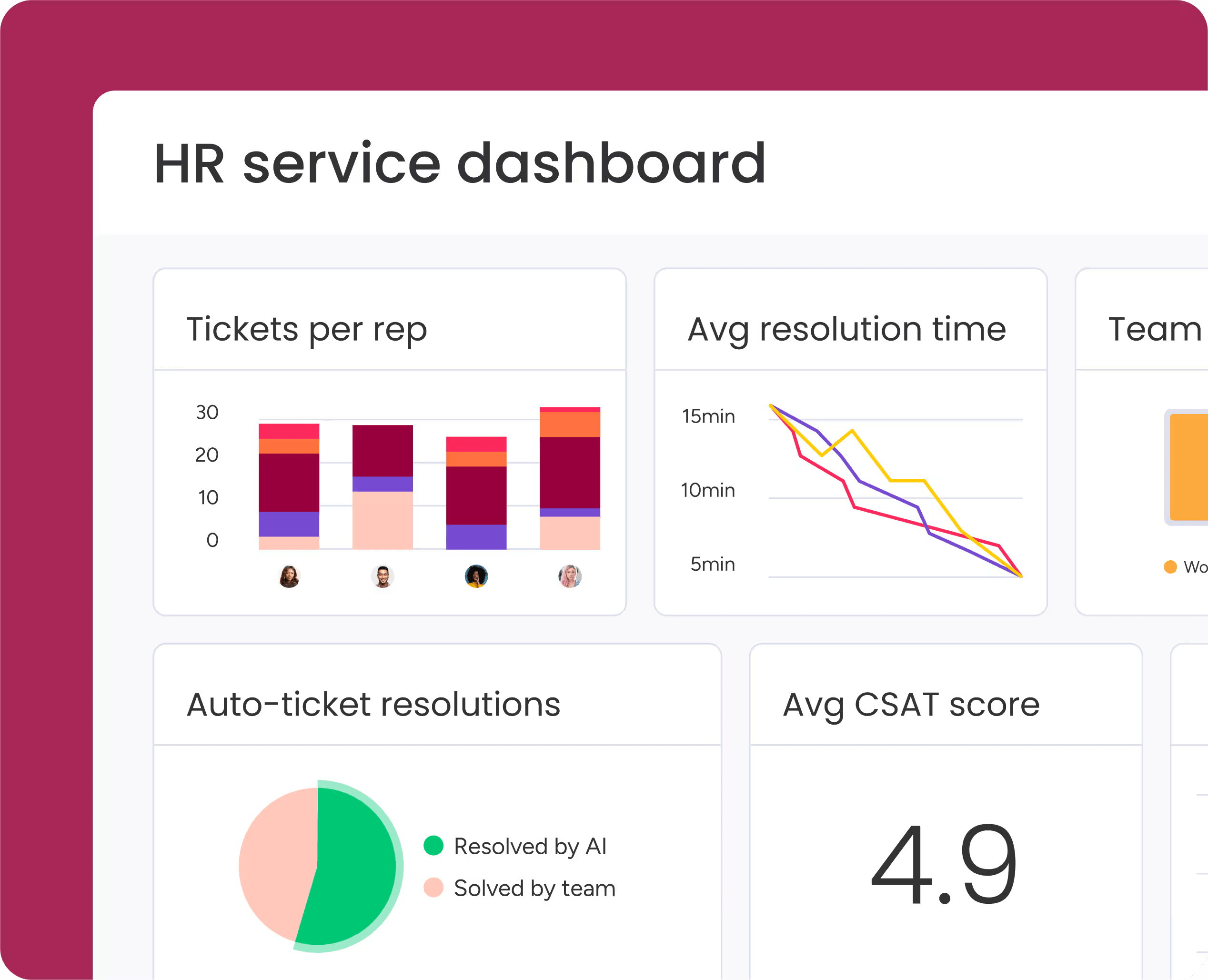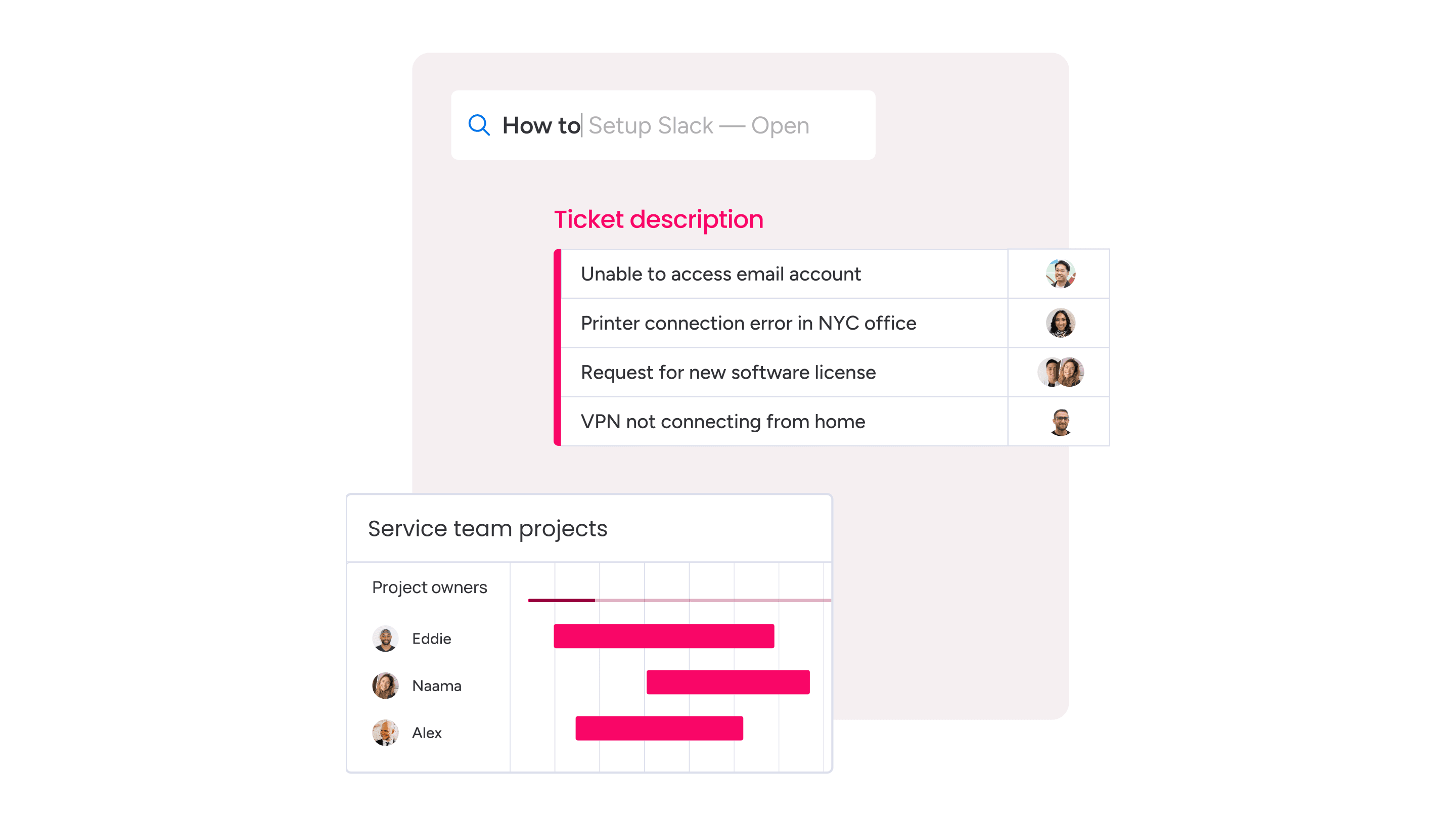Just a few years ago, the concept of an AI assistant was still a far-fetched idea — only something you’d see in a sci-fi movie. And while our perceived vision of what an AI assistant looks like may have morphed a bit from the scary-looking metal figure living in our home, the concept of an AI assistant is unquestionably rooted in our reality.
Today, many businesses rely on advanced AI assistants in the form of what’s known as an AI copilot to simplify their work and boost productivity. Service teams specifically, have embraced AI copilot technology to work smarter, quicker, and more efficiently.
But what exactly is an AI copilot? Why is it so useful? And how can service teams use it to improve their work processes? In this blog post, we’ll cover all of that. Plus, we’ll introduce monday service, the intuitive software for any team to leverage AI assistance to deliver efficient service at scale.
What is an AI copilot?
An AI copilot is an artificial intelligence-powered virtual assistant that supports humans in increasing productivity and efficiency in their work. They’re built upon LLMs (Large Language Models) that analyze data and detect patterns to enable human-like conversations — resulting in a type of virtual assistance that’s as intelligent as possible. The most well-known example of an AI copilot is ChatGPT, but many work management tools have leveraged AI copilot technology into their software for users to maximize productivity — monday service being a prime example of this.
How are AI copilots different from traditional chatbots or virtual assistants?
An AI copilot isn’t just a chatbot or virtual assistant— largely due to its ability to offer proactive service rather than just responding to requests. It actually leverages AI technology to predict solutions, setting out to improve workflows even before someone may have even noticed there was a problem. Additionally, this technology can be distinguished from other basic AI assistant tools because it:
- Integrates within workflows — AI copilots can be built into existing work tools and processes so they become a natural part of everyday business operations rather than a separate tool.
- Learns from previous interactions — AI copilots consistently leverage information to improve abilities, a concept known as continuous learning.
- Autonomously automates tasks — AI copilots use their advanced knowledge to dynamically adjust workflows, auto-prioritizing tasks, and even resolve issues without human intervention (if specifically programmed to do so).
How do AI copilots work
AI copilots work by combining a mixture of three AI technologies
- Generative AI enables AI copilots to create content, suggest solutions, and automate workflows based on user input.
- Large language models (LLMs) allow AI copilots to understand complex queries, generate human-like text, and improve responses over time through deep learning.
- Natural Language Processing (NLP) helps AI copilots interpret, process, and respond to text or voice inputs in a way that feels intuitive and context-aware.
Breaking down the process of an AI Copilot
The process of an AI copilot of course varies amongst different technologies, but the way it works generally looks like this:
Step 1: User input
Somebody interacts with the copilot, asking it to do something through a text/voice command.
Step 2: Analysis
The copilot analyzes the response, considering past interactions, user history, and workflow context.
Step 3: Response generation
The copilot will leverage its LLM technology to retrieve relevant information from internal knowledge bases and databases. It will also leverage Machine Learning (ML) technology that analyzes historical data to detect trends, identify potential bottlenecks, and recommend solutions.
To sum it up, the AI copilot will craft a personalized response based on data-driven recommendations.
Step 4: Task Execution & Automation
Depending on the command, it may automatically trigger actions for the copilot to carry out, such as categorizing requests, assigning tasks, generating reports, or sending notifications.
Step 4: Learning
The copilot uses self-learning algorithms, observing how you interact with its responses to adapt to user preferences and improve results.
Want to learn about how to integrate AI into your workflows? Check out our best tips on integrating AI.
Benefits of using an AI Copilot
Beyond the obvious convenience factor, AI copilots bring tangible benefits that can transform how teams operate.
1. Increased productivity
By automating mundane tasks, providing quick access to information, and streamlining workflows, AI copilot technologies free up time for employees to focus on the more complex and creative tasks that require real human input.
2. Cost saving
For most business operations, time is money, and by freeing up employees’ time, AI copilots naturally reduce the need for extra operational costs.
3. Smart decision making
AI copilots automatically analyze tons of data — anything from datasets, patterns, or past interactions — to draw smart, reliable insights in real time. Plus with the use of predictive analysis, AI copilots can help humans make proactive decisions based on trends. This ensures the user is considering all necessary information to make the smartest decision possible.
4. Enhanced customer experience
AI copilots empower teams to provide faster, context-aware, and personalized customer support. Copilot technology is seen in AI agents, like monday AI — providing customers with instant, 24/7 personalized interactions, automated updates, and guided self-service.
How AI copilots are transforming service management
The rise of the AI copilot is transforming the entire service management landscape. When used correctly, it can help various service teams — from IT, help desk, and HR to finance — deliver faster, smarter, and more seamless support experiences. Here’s how :
Automate ticket management
An AI copilot has the power to automatically categorize, prioritize, and assign service requests based on urgency and context.
Example: A copilot can be programmed to categorize HR tickets according to priority. This ensures critical issues are instantly addressed by the right person while routine inquiries can be directed to a customer portal. This streamlines HR processes by creating a space that provides answers quickly without taking up extra HR resources.
Enable self-service solutions
An AI copilot can locate knowledge from a knowledge base and use it to respond to employee or customer inquiries.
Example: Instead of filing an IT request to be reviewed by an agent, someone with a simple issue can ask the AI service agent for help. The AI service agent will automatically retrieve and send a relevant answer based on the knowledge base. Again, this speeds up the IT processes and reduces the need for human intervention on mundane tasks.

monday service AI assistant: leveraging AI copilot capabilities for success
The most useful types of AI copilots are the ones that seamlessly integrate with your existing service platform. This is why we include a dynamic monday service agent as an integral part of our AI-powered service management platform, monday service. Our AI assistant has capabilities to interact with users to boost productivity and efficiency for a variety of service management solutions.
Here are its leading features and use cases:
AI suggestions for faster ticket handling
Receive AI-powered suggestions on how to solve tickets based on past solutions, existing conversations with requesters, and other important contexts.
AI-powered suggestions make ticket handling smoother by providing quick insights and actionable steps you can review and implement with the click of a button.

AI-powered columns for automatic ticket classification and smart routing
Add AI-powered columns into your workflows that automatically label ticket type, priority, department, and sentiment so requests automatically get assigned to the relevant worker and are dealt with in a timely manner.

Real-time dashboards to monitor trends and predict issues
Customize dashboards to track service performance and monitor trends in real time. Generate interactive reports that analyze all information to identify patterns quickly so your teams can make the smartest decisions possible.

Knowledge base assistance for self-service solutions
Customers and employees can instantly retrieve relevant information from a centralized AI knowledge base to resolve common issues. This reduces agent workload, and allows common issues to be solved as quickly and efficiently as possible.

Reliability and trust in copilots in 2025
While AI copilots are boosting efficiency and creating more productive work environments, they must be used responsibly. The first step in ensuring a responsibly used copilot is considering the copilot technology you’re using. It’s important to use an AI copilot that minimizes data security concerns and AI bias and requires human oversight for reliable AI responses.
monday service ensures ethical AI use by implementing layers of security and moderation to ensure safe and reliable AI experiences.
- Privacy first: we don’t allow for customer input/output to train our machine-learning models.
- Enterprise grade encryption to safeguard data: all information is encrypted both in transit (TLS 1.3) and at rest (AES-256), ensuring reliable protection against unauthorized access.
- User control over AI permission: our AI capabilities follow the existing permissions within your account. If a team member doesn’t have access to specific boards or columns, AI won’t retrieve or display any data from them.
- Prevention of harmful and biased content: we embed fairness, transparency, and accountability in our AI design to safeguard against harmful or biased content, proactively mitigating risks and upholding ethical standards.
- Transparency into our AI capabilities: all our AI technology provides clear indications and actionable information about how it operates and manages your data.
If you’re interested in learning more about how we prioritize responsibility in our AI technology, feel free to visit monday.com’s AI Trust Center.
The future of AI copilots and AI assistants
AI copilots are expected to continue evolving, becoming even more intuitive, predictive, and seamlessly integrated into business workflows. They have great potential to enhance efficiency, improve decision-making, and optimize service management processes.
But regardless of how advanced AI copilot technology becomes, it will only ever be as effective as the human beings it’s being used by.
The Merriam-Webster dictionary defines a traditional copilot as “a qualified pilot who assists or relieves the pilot but is not in command,” which can be aptly applied to our understanding of an AI copilot. This technology is used to assist or relieve an individual in their work but is not, and shouldn’t be, in command. Their purpose is not to “take over” the human workforce but rather to support us as human beings — a tool that gives us the control to work as creatively and effectively as possible.
Set your teams up for success by using a service platform that responsibly leverages the power of AI copilot technology — one like monday service.
FAQs
What is an AI copilot used for?
help with a variety of use cases amongst a variety of industries — from HR, to customer service to IT — all intended to enhance productivity and efficiency. Some common uses include:
-Content generation
-Task automation
-Workflow automations
-Data analytics
Is copilot the same as ChatGPT?
ChatGPT uses copilot technology such as LLMs and Gen AI, and can be considered by many as a type of copilot. ChatGPT, however, is different from traditional copilots because it does not integrate as deeply into workflows.
What is the Microsoft AI copilot?
Microsoft AI Copilot is a popular AI copilot assistant integrated into the Microsoft 365 ecosystem. It’s marketed as a “digital companion” with a conversational chat interface to assist and enhance productivity.
 Get started
Get started 

